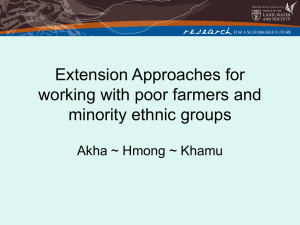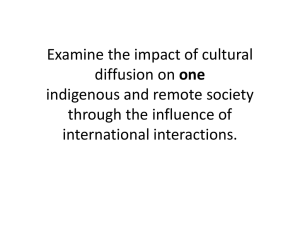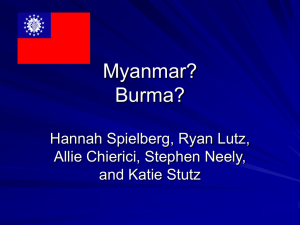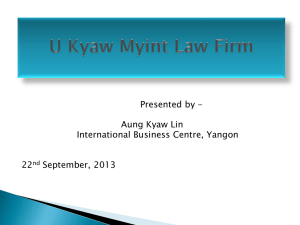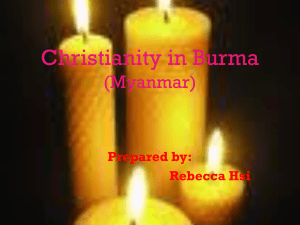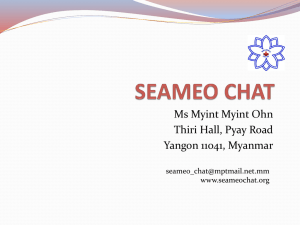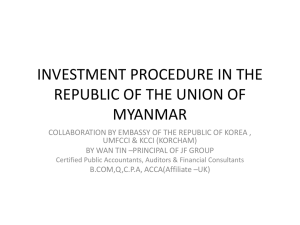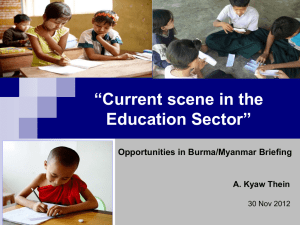Language Vitality among the Akha in Myanmar
advertisement
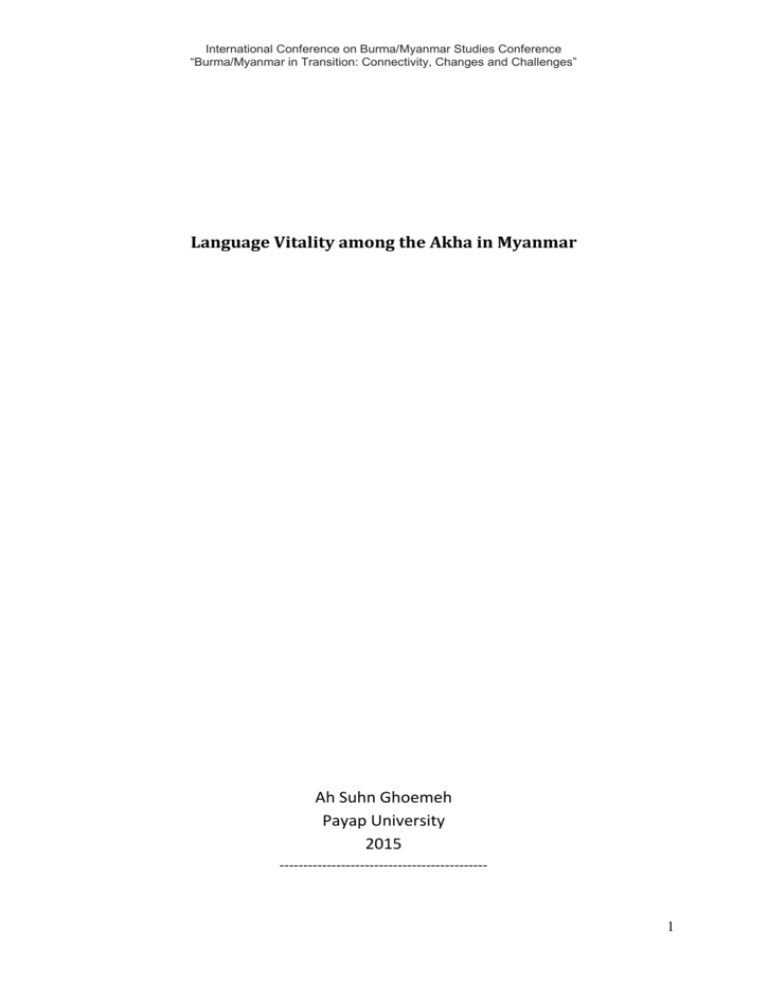
International Conference on Burma/Myanmar Studies Conference “Burma/Myanmar in Transition: Connectivity, Changes and Challenges” Language Vitality among the Akha in Myanmar Ah Suhn Ghoemeh Payap University 2015 -------------------------------------------- 1 International Conference on Burma/Myanmar Studies Conference “Burma/Myanmar in Transition: Connectivity, Changes and Challenges” Abstract The spread of telecommunications networks and the growth in cross-border trade and travel bring minority language communities in Myanmar into ever greater contact with external influences presenting those communities with new choices and new challenges for their language, culture and group identity. In this context, it is important for a community to be able to assess the vitality of their language at the present moment as well as the likely direction of movement in coming years. This paper describes a sociolinguistic study of language vitality of the Akha communities in Eastern Shan State, Myanmar. Fieldwork involved data collection in 18 Akha villages during Apr-Jul 2014. Factors including Age, Gender and Religious Affiliation were used in the research design. The Extended Graded Intergenerational Disruption Scale (EGIDS) (Lewis & Simons 2015:104-117) was used to characterise language vitality and the FAMED conditions (Lewis &Simons 2015:159-189) to assess the extent to which the current level of vitality is sustainable. Overall, Akha language vitality was assessed at EGIDS level 5: “the language is used orally by all generations and is effectively used in written form in parts of the community (Lewis & Simons 2010:110)”. The study found considerable dissimilaritiesamong different villages, with religious affiliation a major predictor of literacy proficiency and usage. The role of the non-formal literacy program operating in Christian villages in sustaining the current level of vitality will be discussed. 2 International Conference on Burma/Myanmar Studies Conference “Burma/Myanmar in Transition: Connectivity, Changes and Challenges” 1 Introduction Since civilian government wasre-established in Myanmarin 2011 many reforms have been introduced at the national level. These reforms have paved the way for rapid changes in many areas of life (Chalk 2013). In telecommunications for example, the usage of mobile phones has been transformed as the price of a sim card fell from $2000 in 2009 to $1.50 in 2014, making the technology affordable for the first time to a wide section of the public (Motlagh 2014). In the area of relations with neighbouring countries, the increase incross-border trade and the easing of restrictions at border crossings has also opened up Myanmar to more contact with outside influences (Mon 2014). Such changes present speech communities with choices about how to communicate in new situations. Mufwene (2002:23) attributes most occurrences of language shift as responses by speech communities to changes in their socio-economic ecology.In this context, it is important for a community to be able to assess the vitality of their language at the present moment as well the likely direction of movement in the future. 1.1 Akha people and language Linguistically Akha belongs to the Ngwi (a.k.a. Lolo) subgroup of Tibeto-Burman languages in the Sino-Tibetan language family. Originally from China, the Akhanow live inrural upland areas of Yunnan Province,P.R.C; Eastern Shan State, Myanmar; northern Thailand; north western Laos, and north western Vietnam (Kammerer 1998:661). Bradley (2007:173) estimates the population of Akha at over 565,000: 240,000 in south western China; over 200,000 in Myanmar; 66,108 in Laos and 56,616 in Thailand. Lewis et al. (2015) estimate anadditional population of 1,260 Akha in Vietnam. This study focuses only on the language vitality of Akha in Myanmar whereAkha communities are located in eleven different townships in Eastern Shan State as shown in the map in Figure 1. Figure 1Akha Communities in Myanmar The Akhaeconomy is based on agriculture. Most Akha villagers grow rice and vegetables for their own consumption. Any surplus produce is sold to raise money. 3 International Conference on Burma/Myanmar Studies Conference “Burma/Myanmar in Transition: Connectivity, Changes and Challenges” 1.2 Akha Cultural and Religious Bodies There are three main religious groups among the Akha in Myanmar: Akha zah1 [ʔa˨kʰa˨zɑ̃ ˦], Buddhist, and Christian (Catholic and Baptist). According to Kya Heh (p.c.) Christians make up around 80% of the Akha in Myanmar, followed by Akhazah with 18% and Buddhists with 2%. As well as the religious groupings which have influence across the many spread out Akha communities in Myanmar, the Akha Cultural Committee (ACC) is a community body that organizes aspects of cultural life for all Akha in Myanmar. Representatives of the three religious groups Christian, Buddhist, and Akha zah, are included in the committee. A key responsibility of the ACC is to organise the Akha New Year festival each year on 28th December. This is an event that brings together Akha from Myanmar, China and Thailand no matter what their religious affiliation. Another important way in which the ACC serves the people is in maintaining a good relationship with the national government. Apart from the ACC, in Keng Tung, there are local cultural committees in various townships around Eastern Shan state. There are also sub-committees with a particular focus such as, women, youth, culture, literature etc. 1.3 Research questions and hypothesis The objectives of this study are to assess the current level and predict the likely future direction of movement of language vitality of Akha in Myanmar. These objectives are encapsulated in the following two specific research questions for this research. Research Question 1. What is the current level of vitality of Akha in Myanmar? Research Question 2. What evidence is there that the current level of vitality of Akha in Myanmar is sustainable? In relation to Research Question 1 the following hypothesis can be stated based on the author’s experience as a member of the community: the vitality of Akha in Myanmar can be assessed as EGIDS2 level 5: “the language is used orally by all generations and is effectively used in written form in parts of the community.” 2 Theoretical Framework Lewis *Simons 2015 proposed the Expanded Graded International Disruption Scale (EGIDS) for measuring the vitality of any language. The 13 levels of the EGIDS are described in Table 1. Table 1Expanded GIDS (Lewis and Simons 2015:105-106) Level 0 1 Label International National Description The language is widely used between nations in trade, knowledge exchange, and international policy. The language is used in education, work, mass media, and government at the The Akha word zah has many senses and can be used in many different ways in the language. The expression Akhazah can be translated as ‘The Akha Way’ and consists of many practices in everyday life, such as cooking an egg or building a house as well as practices that would be considered as religious such as sacrifices after they have not followed some aspect of the zah. This paper will use the term ‘Akha zah’ instead of ‘Akha Animist’ because this is the name they prefer to be called. 2 The EGIDS is described in Section 2. 1 4 International Conference on Burma/Myanmar Studies Conference “Burma/Myanmar in Transition: Connectivity, Changes and Challenges” 2 3 4 5 6a 6b 7 8a 8b 9 10 national level. Provincial This language is used in education, work, mass media, and government within major administrative subdivisions of a nation. Wider The language is used in work and mass media without official status to Communication transcend language differences across a region. Educational The language is in vigorous use, with standardization and literature being sustained through a widespread system of institutionally supported education. Developing The language is in vigorous use, with literature in a standardized from being used by some though this is not yet widespread or sustainable. Vigorous The language is used for face-to-face communication by all generations and the situation is sustainable. Threatened The language is used for face-to-face communication within all generations, but it is losing users. Shifting The child-bearing generation can use the language among themselves, but it is not being transmitted to children. Moribund The only remaining active users of the language are members of the grandparent generation and older. Nearly Extinct The only remaining users of the language are members of the grandparent generation or older who have little opportunity to use the language. Dormant The language serves as a reminder of heritage identity for an ethnic community, but no one has more than symbolic proficiency. Extinct The language is no longer used and no one retains a sense of ethnic identity associated with the language. Level 0 is the highest level of language vitality and describes a situation where the language is widely used at an international level for knowledge exchange and international policy. At the other end of the scale is level 10, where no one remains who can speak the language. Such languages are classified as ‘extinct’. The levels highlighted in grey are said to be sustainable and will be discussed further in section 2.1. 2.1 Sustainable Use Model The rapid spread of modern technology as well as globalization can cause language vitality to decrease among minority language groups. Lewis &Simons (2015) developed the Sustainable Use Model (SUM) as a framework for language development planning and appraisal. The SUM uses the EGIDS to measurethe current level of vitality. A key insight of the SUM is that certain levels of language vitality are sustainable, whereas other levels are not sustainable in the long term. The four sustainable levels, namely, sustainable history, sustainable identity, sustainable orality and sustainable literacy, are hierarchical, that is sustainability at a higher level implies sustainability at all lower levels. In the case of sustainable history (EGIDS level 10), the language is no longer spoken and does not serve any function in the community even though it has been documented adequately and it is archived safely and reliably. In the case of sustainable identity (EGIDS level 9), there are no proficient speakers of the language. The members of the community remember the language but do not speak it. They identify the language as the language of previous generations. However, they might use very limited amounts of the language for example in ceremonies or other cultural events to express their identity and heritage. In the case of sustainable orality (EGIDS level 6a), the community members speak the language as their first language, and they transmit the language to 5 International Conference on Burma/Myanmar Studies Conference “Burma/Myanmar in Transition: Connectivity, Changes and Challenges” their children. In the case of sustainable literacy (EGIDS level 4), all generations in the community have the ability to speak the language and literacy in their language is taught throughout the community, typically by the public education system. 2.2 FAMED Conditions The FAMED (Function; Acquisition; Motivation; Environment; Differentiation) conditions (Lewis & Simons 2015:159) provide a framework for examining the factors behind the observed patterns of language use in the community.The conditions also help to identify activities that the community can engage in to raise the vitality of their language. The FAMED conditions are outlined inTable 2. Table 2 FAMED conditions (Lewis & Simons 2015:159) Condition Functions Acquisition Motivation Environment Differentiation Description Functions (uses, bodies of knowledge) associated with the language must exist and be recognized by the community. A means of acquiring the needed proficiency to use the language for those functions must be in place and accessible to community members. Community members must be motivated to use the language for those functions. They must perceive that the use of the language is beneficial in some way. The policy environment (including at national, regional, and local levels) must not be hostile to the use of the language for those functions. Societal norms must clearly delineate the functions assigned to the local language marking them as distinct from the function for other languages in the speech community’s repertoire. 2.3 Research Instruments This research is based on two fieldwork trips in Eastern Shan State. The first trip focused on details of the Akha literacy program and visited 6 villages in Kengtung Township and 7 villages in Tachileik Township. The second trip focused on language use and language attitudesvisiting 2 villages in Kengtung, 2 in Tachileik and 3 in Nam Pan. Two villages were visited on both trips so a total of 18 different villages were included in the study. The following instruments were designed and used: Individual Sociolinguistic Questionnaire (ISLQ); Knowledgeable Insider Questionnaire (KIQ); Christian Leader Questionnaire (CLQ); Akha Zah Leader Questionnaire (ALQ); and Teacher Interview Questionnaire (TIQ). The full instruments are too long to be included in this paper but can be found in Ghoemeh (2015). 3 Assessing Akha language vitality Lewis et al. (2015) propose an EGIDS level of 3 for Akha in Myanmar , presumably because it is spoken as an L2 by “other minority people who live among them (Lewis & Simons 2010:110).”Ghoemeh (2015) argues that the EGIDS level for Akha in Myanmar should be 5 because the language enjoys strong oral use and the written form is used by parts of the community but literacy is not taught in the government school system. Lewis & Simons (2015:111) characterise level 5 as: “This is the level at which literacy is incipient, more often than not informal educational structure and systems and with only weak or transient societal institutional support.” The SUMholds that unless the vitality of Akha can be raised to the next sustainable level above its current position, i.e., level 4, then in the long-term it will eventually fall to level 6a.This section uses the FAMED conditions to examine medium-term sustainability. 6 International Conference on Burma/Myanmar Studies Conference “Burma/Myanmar in Transition: Connectivity, Changes and Challenges” 3.1 Function This section presents data about patterns of language use in the Akha villages. By identifying what language Akha people use in different areas of life, it is possible to infer the functions that the language serves in these communities. Table 3 shows the patterns of language use in the religious domain in Akha Christian villages. The data comes from interviews with Christian leaders in 16 Christian villages over the two fieldtrips. Table 3Language use in Religious Domain in Christian communities Question on CLQ 25. What language Bibles are used in your church? 27. What languages do the preachers use when they preach in your church? 28. What languages are used for opening prayer in your church? 29. What languages are used for singing in your church? 30. What languages are used to make announcements in your church? 31. What languages are used during fellowship times [conversations between church members]? 32. What languages are used by the youth in your church? 32b. What languages are used for singing by the youth? Answer Akha Burmese Akha Burmese Lahu Akha Burmese Akha Burmese, Chinese, Lahu Akha Baptist 13 [93%] 1 [7%] 13 [93%] 0.5 [3.5%] 0.5 [3.5%] 14 [100%] 0% 12 [86%] 2 [14%] 13.5 [96%] Catholic 1.5 [75%] 0.5 [25%] 1.5 [75%] 0.5 [25%] 0% 2 [100%] 0% 2 [100%] 0% 2 [100%] Burmese 0.5 [4%] 0% Akha 12.5 [89%] 1.5 [75%] Burmese, Lahu 1.5 [11%] 0.5 [25%] Akha Burmese Akha Burmese 8 [57%] 6 [43%] 7 [50%] 7 [50%] 1.5 [75%] 0.5 [25%] 2 [100%] 0% In the Christian villages, most of the activities in the domain of religion are done using Akha but some other languages are also used in a small number of situations. As the numbers in the table show, most activities are dominated by Akha apart from language use by young people, especially in Baptist villages where Akha and Burmese are each used about 50% for singing in church. Table 4 shows patterns of language use in the religious domain from interviews with religious leaders in two Akha Zahvillages. Table 4Language use in Religious Domain in Akha Zahvillages Question on ALQ 29. What language do they use when they do for religious things? 30. What languages are used when they recite/chant? 31. What languages are used for announcements? 32. What languages are used for festivals? 33. What languages are used for funeral? 34. What languages are used for visiting? 35. What languages are used when talking in your family? 36. What languages are used [for other activities]? 37. For all your religious activities, which language is used most? N 2 2 2 2 2 2 2 2 2 Akha 2 [100%] 2 [100%] 2 [100%] 2 [100%] 2 [100%] 2 [100%] 2 [100%] 2 [100%] 2 [100%] 7 International Conference on Burma/Myanmar Studies Conference “Burma/Myanmar in Transition: Connectivity, Changes and Challenges” Patterns of language use in the religious domain in Akha Zahvillages also show that Akha is very strong. They use only Akha for all aspects of religious things. The religious domain is the main area that motivates language development in Akha. Most of the books that have been produced in Akha are religious books especially in the Christian community. Christian leaders or pastors need to be literate in Akhabecause most Akha communities include people who do not have a good understanding of any language apart from Akha. Even though some Akha are in the city, they only use Akha in Church except for some young people who like to sing the modern Christian songs that have been written recently in other languages [English, Burmese, or Chinese], especially Burmese. So Akha language maintenance in the religious domain is very strong. Another domain of vital importance to language maintenance is the home domain. Table 5 shows data for language use in the home. Table 5 Patterns of language use in the home domain Question on ISLQ 27. What language do you speak at home with 27[a]with your parents? 27[b]with your grandparents? 27[c] with your siblings? 27[d](if married) with your spouse? 27[e](if have children) with your children? 27[f](if old and have children) with your grandchildren / nieces / nephews? 27[g] In your house What language do you use the most? N Akha Nam Pan 36 36 [100%] Tachileik 24 24 [100%] Keng Tung 24 24 [100%] Akha 36 [100%] 24 [100%] 24 [100%] Akha Akha Burmese Chinese Akha Chinese 36 [100%] 28 [93%] 1 [3.5%] 1 [3.5%] 26 [96%] 1 [3%] 24 [100%] 18 [100%] 17 [100%] - 24 [100%] 18 [100%] 18 [100%] - Akha 23 [100%] 19 [90%] 19 [100%] Burmese - 1 [5%] - Chinese - 1 [5%] - Akha Burmese 35 [97%] 1 [3%] 24 [100%] 0% 24 [100%] 0% Almost every household speaks Akha at home with their parents, grandparents, children, and grandchildren. In all three areas Akha is the dominant language in the home domain. Table 6 shows the language use in social setting outside the home. Table 6 Language use in social setting outside the home 27 [i] At the market [j] At the funeral [k] At the village meeting [l] With government officer Akha Other languages Akha Burmese Akha Burmese Akha Burmese Nam Pan 17 [47%] 19 [53%] Tachileik 5 [21%] 19 [79%] Keng Tung 6 [25%] 18 [75%] 35 [97%] 1 [3%] 36 [100%] 0% 35 [97%] 1 [3%] 22 [92%] 2 [8%] 24 [100%] 0% 3 [13%] 21 [87%] 20 [83%] 4 [17%] 24 [100%] 33 [12%] 7 [30%] 17 [70%] Note this use of Burmese is with those who are unable to speak Akha, so the Akha speakers have no choice but to use Burmese to communicate. 3 8 International Conference on Burma/Myanmar Studies Conference “Burma/Myanmar in Transition: Connectivity, Changes and Challenges” The data in Table 6 show that generally in the market setting Akha is used about half the time in Nam Pan area compared to about one quarter of the time in Tachileik and Kengtung. This is because of the various language groups who come to the markets in the different locations.At funerals or village meetings Akha is the predominant language used, whereas there is some variation depending on the area in which language is used with government officials.In Tachileik and Keng Tung areas people speak mostly speak Burmese with government officials whereas only 1/36 [3%] from Nam Pan area speaks Burmese and 35/36 [97%] of them speak Akhain this setting. 3.2 Acquisition The Acquisition condition concerns how much support there is for people to acquire proficiency in Akha, whether it is oral or written proficiency. Since Akha is the dominant language of community life and the vast majority of parents transmit Akha to their children, there is strong support for acquisition of the oral form of the language. This section therefore focuses on acquisition of the written form of the language. 3.2.1 Akha orthography Over the years many orthographies have been developed for Akha. The Roman Catholic Akha orthography (CAO) was originally created about 100 years ago, although it was revised around 1985.The Baptist Akha orthography (BAO) was developed around 1949 and was widely used in Baptist villages. The Burmese script Akha orthography was created in around 1970 however, the orthography was found to have problems representing the language so people stopped using it. In order to promote unity the Unified Akha Orthography was developed in 2004 and has gradually been adopted since then particularly by Catholics and Baptists. After the creation of the UAO, however, another orthography was created named the KhanqgmAqkaqSanqbovq [qʰɑ̃ ˨gm̩ a˨kʰa˨ sɑ̃ ˨ɓo˨ʔ] (hereafter KHAS) or alternatively the Common Akha Orthography (CAO). The creators tried to get it used by the whole Akha community throughout Southeast Asia. However the Christian and Buddhist communities in Myanmar didn’t accept the KHAS. Furthermore there are different Akha orthographies in use in other countries as well. So it did not gain acceptance by the whole Akha community. To sum up, the UAO is most widely used by the Akha in Myanmar. The AkhaBaptist Convention (ABC) literacy program is using UAO for all literacy classes. All ABC literacy materials use the UAO. Baptist, Catholic, and Buddhist Akha are using UAO whereas some of the Akha zah are using KHAS. 3.2.2 Akha written materials The Akha translation of the Bible was published in 1940 (New Testament) and in 2001 (Old Testament and New Testament revision), and it is used in all churches in the Akha Baptist Convention. Most written materials in Akha are produced by the Christian community. Apart from Christian teaching materials, various literacy materials have been developed. Another aspect of acquisition view is literacy process. Akha has primer, and there are plans to produce a post primer soon. Teacher training for literacy teachers was conducted in Thailand by SIL. After that some other materials such as big books, story books, and a picture dictionary were produced to help the students improve their reading. Many Akha Baptist villages now have a village library, and there are over 32 different books, with over 749 pages, written in Akha, available for the villagers to read. These books are mainly short stories with pictures written at a beginners’ level. Akha Christians also have the Bible which is over 1000 pages. 9 International Conference on Burma/Myanmar Studies Conference “Burma/Myanmar in Transition: Connectivity, Changes and Challenges” 3.2.3 Akha literacy program The Akha literacy program is run mainly in the Baptist community. Almost all of the literacy teachers are pastors who are automatically expected to teach Akha literacy for the villagers. To prepare the pastors to teach Akha in their village, the teacher training is held for students of the Akha Bible School every year. In fact it has become part of the curriculum in the Bible School. This shows that even though Akha is not currently used in the government education system, acquisition of Akha literacy is supported by at least one institution, namely the Akha Baptist Convention. The author met pastors who got the literacy training from the Bible school and have since taught literacy in the villages where they are serving. Having the opportunity to learn Akha literacy is very much appreciated by the villagers. 3.2.4 Akha literacy rates and proficiency This subsection focuses on the current rates of L1 literacy in the Akha community. The current literacy rates strongly depend on which religious community a person belongs to, with Baptists having the highest rate followed by Catholics. The estimated literacy rate among Akha Zahfrom the villages in the survey is very low. Since the resources described in the previous subsections have all seen changes in the last decade, it is too soon to see much effect of those changes on the literacy levels in the community. However the changes would be expected to enhance the resources and provide greater opportunity for acquiring the written form of Akha, so one would expect that the literacy rates might increase in the future, if other factors do not change. No data was collected on proficiency levels, but some comments are possible based on what is known about the Christian community. Most Christians are motivated to learn to read in order to be able to read the Bible and hymnal, so most would have regular practice at reading complex reading material. The number of people who say they can write is much lower than the number who can read. From the author’s knowledge as a member of the Akha community, it can be said that most people are limited in their writing proficiency in Akha. Even some people who are educated in Burmese or an international language such as English have a hard time to write well in Akha because they were educated in Burmese or English but not in Akha. Writing in Akha is seen only in the religious domain and for some special events, such as the Akha New Year festival, weddings, anniversaries, etc. The author would say that even though many Akha Christians are able to perform basic writing tasks such as writing their names, typically only pastors and a few highly educated people are able to write Akha at a more advanced level. 3.3 Motivation The more reasons there are for Akha speakers to use their language, the more sustainable the use of the language at a particular level. This section discusses data relating to why Akha people might be motivated to use their language. The Akha Baptist community is the most active in its use of Akha both in orally and in written form. The ABC uses Akha as its official language. Minutes from meetings, reports, invitation letters, and many other things are written in Akha. Since being able to read the Akha Bible is highly valued by members of the Baptist community, there is strong motivation to be literate in Akha. This in turn motivates people to support the running of a literacy class in their village. The pastors always preach in Akha, and almost all of the church activities, prayer, Bible reading, hymn singing, and announcements, are done in Akha. There is therefore strong motivation to have high oral proficiency in Akha as well as being literate in Akha. 10 International Conference on Burma/Myanmar Studies Conference “Burma/Myanmar in Transition: Connectivity, Changes and Challenges” The Akha Zah, Catholic, and Buddhist Akha communities have strong motivation to be orally proficient, but not very much in writing and reading. They only use Akha in written form occasionally when holding community or family events. Table 7gives an indication of the attitude toward their own language by the advantages they perceive to being literate in Akha. Table 7 Advantages of being able to read and write Akha Question Do you see advantages in being able to read and write Akha? (if yes) What advantage? Answer Yes No response Total Religious Business Record keeping “Everything” Other Total ISLQ-39 64 [76%] 20 [24%] 84 27 [32%] 6 [7%] 5 [6%] 4 [5%] 18 [21%] 60 [71%] KIQ-56 17 [94%] 1 [6%] 18 6 [33%] 2 [11%] 3 [17%] 2 [11%] 4 [22%] 17 [94%] CLQ-41 16 [100%] 0% 16 14 [88%] 2 [12%] 16 [100%] As shown in Table 7, 16/16 [100%] of the Christian leaders, see the advantages of being able to read and write Akha since they need to use it in their work. Also, 17/18 [94%] of the village leaders and 64/84 [76%] of individual subjects see the advantages of being able to read and write. It should be noted that those who did not say ‘Yes’ gave no answer, rather than saying ‘No.’ It is likely that they may find it difficult to answer this question since they are not literate and have never experienced reading and writing. By far the biggest category of perceived advantages to Akha literacy was the religious domain with 27/84 [32%] of individuals, 6/18 [33%] of village leaders, and 14/16 [88%] of Christian leaders citing this. The rest of the respondents said there are many other advantages of being able to read and write Akha. Some uses mentioned for business include keeping records; being able to read numbers such as written on money or the telephone; and being able to sell and buy things. Other advantages include composing Akha songs, and teaching their children. Table 8 shows the attitude toward their own language by their reported primary ethnic identity. Table 8 Primary ethnic identity Question ISLQ-40. Do you think of yourself first as Akha, Burmese, or something else? Answer Akha Burmese Depends on the situation Nam Pan 36[100%] 0% 0% Tachileik 21 [88%] 2 [8%] 1 [4%] Keng Tung 21 [88%] 1 [4%] 2 [8%] All three areas show that Akha people have a strong identity as Akha with 36/36 [100%] of participants from Nam Pan area saying they think of themselves primarily as Akha. 3.4 Environment Sustainability of language use is affected by the environment: both external factors, such as government policy,and factors within the community, such as community cohesiveness and unity, can affect vitality. The Myanmar government officially recognises 135 ethnic groups including Akha, 11 International Conference on Burma/Myanmar Studies Conference “Burma/Myanmar in Transition: Connectivity, Changes and Challenges” so it has the status of an officially recognized group in Myanmar. Government education policy is currently quite complicated for ethnic minority groups since there are many different ethnic groups but the language of educational instruction is Burmese. There are many people, who only speak their mother tongue at home, before they go to school. So many students find it difficult or even impossible to understand what their teachers are saying. They could not completely understand for at least the first one or two years of their school life. However sometimes they gradually learn the language and grow in their understanding of the learning process after the fourth or fifth year of school. Those children who attendan Early Childhood Care and Development(ECCD)preschool program generally do better in school compared with those who have never gone to ECCD, even though they could not learn in government schools in their mother tongue, Akha. But there are very few students who can go to ECCD before they go to the school. Only those who live in the city or certain villages where ECCD is provided by an NGO can have the opportunity. Since most of the Akha people live in upland areas, they could not have opportunity to have ECCD in their villages. So they face many struggles in their education. Many students stop going to school after they complete primary or secondary school. The Myanmar Multiple Indicator Cluster Survey 2009-2010 [MICS] (Ministry of National Planning and Economic Development and Ministry of Health, Myanmar 2011) presents various regional, divisionlevel, and national statistics. According to MICS, the rate of primary school completion and the rate of transition to secondary education in Eastern Shan State are 97.0% in 2009-2010. Seeing this number the rate of the transition is strong. However it should be remembered that this number is for the whole of Eastern Shan State, not just for Akhacommunities. It is likely that the figure for Akha would be lower because many Akha live in villages where it is difficult for children to go to school. One of the reasons why the Akha students stop going to school after finishing the primary or secondary school is most of them have to go to another village or city to continue their studies. Secondly, they are often not happy to go to school because of the extra difficulties they face since they cannot have a chance to learn in their mother tongue. Thirdly, if they go to the city they have to mix with more people groups who speak other languages that they cannot understand. Yet another reason might be that the children are needed to help their parents, for example the parents need help to work in the farm or to take care of their animals. However, in the author’s experience nowadays only a few people ask their children to help in the farm instead of going to school. 3.5 Differentiation Differentiation is the use of two or more languages for different functions within a community. The more stable the usage of particular languages for particular functions, the more sustainable the language. As shown in section 3.1 above, there is very strong usage of Akha in the home domain as well as in the religious domain. The data in Table 9 give some insight into Akha language proficiency. Table 9 Akha language proficiency Question number on KIQ 37. Are there people in this village who can only speak Akha? Yes 9 [50%] No 9 [50%] Akha 12 International Conference on Burma/Myanmar Studies Conference “Burma/Myanmar in Transition: Connectivity, Changes and Challenges” 38. Are there people in this village who can speak Akha, but not very well? 1 [6%] 17[94%] 39. Are there people in this village who cannot speak Akha at all? 40. Normally what language do the children in this village speak first 0 18[100%] 18[100%] According to this analysis half of the village leaders, 9/18 [50%], responded that there are still people who can only speak Akha in their villages. They also said that there is no one who cannot speak Akha at all but there is one person who cannot speak very well. Data relating to children’s language use is presented in Table 10. Table 10 Children’s language use ISLQ 52, Normally, what language do the children in this village speak first? Nam Pan Tachileik Keng Tung Akha 36/36 [100%] 24/24 [100%] 24/24 [100%] ISLQ 53, Do you think the young people in this village speak your language well? Nam Pan Tachileik Keng Tung Yes 36/36 [100%] 24/24 [100%] 24/24 [100%] As shown in Table 10 above children’s language is 100% Akha in all villages included in the survey. On the survey fieldtrips the author spoke only Akha to people in the villages and she observed that even those who also speak other languages are still able to speak Akha well. However one area where there is lower usage of Akha in the religious domain is the use of Burmese in Christian songs by young people in the Akha Baptist churches. This is a matter of some concern because it suggests that Akha might lose its dominant position if this usage spreads to other areas of church life. Table 11 shows the patterns of language use of the Languages of Wider Communication (LWCs) by Akha from the three areas. Table 11Patterns of Use of LWCs Question on ISLQ 43. Overall, how well do you speak Shan? 44. How many times a week do you typically speak Shan? 44a. What do you use Shan for? 46. Overall, how well do you speak Burmese? 47. How many times a week do you typically speak Burmese? Answer Well Half A little Not at all Every day Often or sometimes Business Social conversation Nam Pan 2 [6%] 3 [8%] 10 [28%] 21 [58%] 5 [14%] 10 [28%] 6 [17%] 8 [22%] Tachileik 1 [4%] 3 [13%] 11 [46%] 9 [37%] 1 [4%] 10 [42%] 8 [33%] 3 [13%] Keng Tung 1 [4%] 1 [4%] 5 [21%] 17 [71%] 0% 7 [29%] 4 [17%] 3 [13%] Well Half A little Not at all Every day Often or sometimes 1 [3%] 1 [3%] 3 [8%] 16 [44%] 4 [11%] 5 [14%] 12 [50%] 1 [4%] 6 [25%] 14 [58%] 5 [21%] 7 [29%] 1 [4%] 9 [38%] 12 [50%] 4 [17%] 13 International Conference on Burma/Myanmar Studies Conference “Burma/Myanmar in Transition: Connectivity, Changes and Challenges” 47a. What do you use Burmese for? Business Social conversation 4 [11%] 3 [13%] 16 [67%] 18 [75%] 49. Overall, how well do you speak Chinese? Well Half A little Not at all Every day Often or sometimes Business Social conversation 5 [14%] 10 [28%] 7 [19%] 3 [8%] 10 [28%] 18 [50%] 18 [50%] 4 [11%] 6 [25%] - 3 [13%] 1 [4%] 1 [4%] - 50. How many times a week do you typically speak Chinese? 50a. What do you use Chinese for? As we can see from the numbers in Table 11, LWC usage and proficiency depends on the area. Chinese is the leading (i.e. greatest frequency and highest proficiency) LWC in the Nam Pam area, whereas Burmese is the leading LWC in Tachileik and Keng Tung. The Shan language is used in all three areas but of the 37 people who said they speak some Shan, only 11 can speak more than ‘a little’. Even though they speak many different languages, they mostly don’t speak these languages very well. The only language they speak very well is Akha. Only in one of the three areas, (50% in Tachileik) arepeople able to speak Burmese well. Apart from the home, village, church or religious domain, they speak Burmese, Shan, and Chinese for other settings such as the market, school, government office, etc. For Keng Tung and Tachileik areas, Burmese is the most commonly used language in settings outside of the home. However the Nam Pan area, which is in Special Region 4, is different from the other two areas. Even though the population of Chinese in the area is less than the Akha population the influence of Chinese is quite strong. In some villages there is a Chinese school but no Akha literacy class or Burmese government school! However one interesting thing that the author discovered in that area is that Akha is used as second language by people from other ethnic groups. For example, most of the shopkeepers at the Nam Pan market are Chinese and some are Shan but they all speak Akha. Since most of the people of that area are Akha, other people try to speak Akha for their business, to sell things, at the market or to hire people for their farm. Even though some Chinese people speak Akha their proficiency is limited to the topics they need to communicate about, such as selling their goods at the market or matters relating to employing labourers for their farms. Table 12shows data for Burmese reading proficiency. Table 12 Tested Burmese Reading Proficiency by Area Nam Pan Tachileik Keng Tung Total ISLQ 32(a) show Burmese text and ask them to read it aloud Reading speed Mistakes N Num of Fast Medium Slow Every Readers sentence 36 4 [11%] 1[3%] 3[8%] 24 14[58%] 8 [33%] 5[21%] 1[4%] 24 9 [38%] 6 [25%] 2 [8%] 1[4%] 1 [4%] 84 27[32%] 14[17%] 8[10%] 5[6%] 1 [1%] Half of sentences 4 [11%] 5 [21%] 3 [13%] 12[14%] None 9 [38%] 5 [21%] 14[17%] The percentage of people who are able to read confidently in Burmese is very small. In the Nam Pan area, there are only 4/35 [12%] people who can read in Burmese. None of them read fluently. 14/24 14 International Conference on Burma/Myanmar Studies Conference “Burma/Myanmar in Transition: Connectivity, Changes and Challenges” [58%] are able to read in Tachileik area, and 9/24 [38%] of them read fluently. In Keng Tung area, 9/24 [37%] are able to read, and 5/24 [21%] of them read fluently. To understand the differences between the Tachiliek and Keng Tung areas, it is helpful to consider each village separately, as shown in Table 13 below. The villages are listed by area: Bar Leh; SeuNyeh and Hu Naw are from Nam Pan; HoKyin 2 and Panaw from Tachileik and Gawtsum and Bar Aa from Kengtung. Table 13 Tested Burmese Reading Proficiency byVillage Village N Bar Leh SeuNyeh Hu Naw Bar Aa Panaw Gawtsum HoKyin 2 Total 12 12 12 12 12 12 12 84 Num of readers 2 [17%] 2 [17%] 0 6 [50%] 8 [67%] 8 [67%] 1 [8%] 27[32%] ISLQ 32(a) show Burmese text and ask them to read it aloud Speed Mistakes Fast Medium Slow Every Half the None sentence sentences 1 [8%] 1 [8%] 2 [17%] 2 [17%] 2 [17%] 5 [42%] 1 [8%] 1 [8%] 5 [42%] 3 [25%] 5[42%] 4 [33%] 4 [33%] 6 [50%] 1 [8%] 1 [8%] 1[8%] 2 [17%] 5 [42%] 1 [8%] 1 [8%] 14[17%] 8[10%] 5[6%] 1 [1%] 12[14%] 14[17%] The figures in the Num of Readers column inTable 13 show that Burmese literacy rates are low in all three villages in Nam Pan and HoKyin2 village in Kengtung. The low level of Burmese literacy in Nam Pan area is due to the lower number of Burmese government schools. HoKyin 2 village shares a primary school with 3 other villages and the school was possibly not open when many of the participants were of school age. Table 14 shows beliefs about language use twenty years in the future. Table 14 Beliefs about Language Use in the Future ISLQ-55, Twenty years from now, what languages do you think children in this village will be speaking? Answer Nam Pan Tachileik Keng Tung Total Akha 35 [97%] 24 [100%] 23 [96%] 82 [98%] Burmese 27 [75%] 24 [100%] 23 [96%] 74 [88%] Chinese 34 [94%] 3 [13%] 3 [13%] 40 [48%] Shan 1 [3%] 2 [8%] 6 [25%] 9 [11%] Lahu 1 [4%] 8 [33%] 9 [11%] English 3 [13%] 5 [21%] 8 [10%] Thai 2 [8%] 2 [2%] As we can see from the figures in Table 14, 82/84 [98%] of the subjects do believe that their language will be spoken in 20 years’ time. The language with the second highest number of responses is Burmese with 74/84 [88%]. Since Burmese is the national language,it is not surprising that people believe that it will be spoken in the future. In Keng Tung and Tachileik Akha and Burmese were mentioned the same number of times. In other words, people believe that in 20 years’ time children in their village will speak both Akha and Burmese. The language with the third 15 International Conference on Burma/Myanmar Studies Conference “Burma/Myanmar in Transition: Connectivity, Changes and Challenges” highest percentage is Chinese with 40/84 [48%]. In the Nam Pan area people believe that in the future children in their village will speak both Akha and Chinese and to a lesser extent Burmese. This is not surprising because Nam Pan is located next to the China border. Other languages such as Lahu, Shan and Thai are listed because they are important to a particular location, e.g. Thai was listed by two people in Tachileik. 4 Conclusions and Suggestions for further work The overall view of the FAMED conditions of Akha and suggestions for further work are going to be presented in the following sections. 4.1 Conclusions This study provides the most detailed assessment to date of language vitality for Akha in Myanmar. The FAMED conditions provide a good framework to assess the sustainability of the current level of language vitality and naturally identify areas where action is needed to strengthen vitality. The results show thatAkha people speak Akha as the predominant language in their daily life, especially in the domains of home and religion. Oral proficiency is being transmitted strongly and literacy proficiency is being transmitted with institutional support in the Baptist community. The level of vitality is thus EGIDS level 5. The attitude of Akha speakers to their own language was shown to be very strong. People in all religious communities are strongly motivated to speak the language. Members of the Christian community, especially the Baptist community are strongly motivated to read and write Akha, particularly for reading the Akha Bible and hymnal. Although Akha is recognised as an official minority ethnic group by the government, the governmentpolicy of using Burmese as the language of oral and written instruction in school creates an environment that is not supportive of Akha literacy. Although Akha people speak many different languages, they don’t speak other languages very well. Only a small percentage speak Burmese well, but most people believe that over the next 20 years more Akha will be speaking the LWCs, Burmese, Chinese and Shan Generally these can be considered as additive bilingualism in certain domains, primarily trade and business. Drawing these findings for the FAMED conditions together, it can be said that providing the ABC literacy program is maintained,Akha language vitality can remain at level 5 in the medium-term future. Assuming that the government’s language-in-education policy remains the same, the nonformal education sector needs to be expanded in order to strengthen vitality. 4.2 Suggestions for further work There are four other countries, China, Thailand, Laos, and Vietnam, thatAkha people are living in. With the increase of international connections in ASEAN there will be greater opportunity in the future for more contact between Akha in different countries in the region. So further research should be done on Akha language vitality in those countries. It is likely that insights about language vitality can be gained by comparing the vitality of Akha in the different countries.Although some adaptations will be needed when doing the research for those other countries, as far as possible the research tools should be the same as the tools that used for the present study so that the results will be easier to compare. 16 International Conference on Burma/Myanmar Studies Conference “Burma/Myanmar in Transition: Connectivity, Changes and Challenges” References Bradley, David. 2007. East and south-East Asia.Atlas of the World’s Languages, ed. by R. E. Asher, Christopher Moseley and Giles Darkes, 159-197.Routledge. Chalk, Peter. 2013. On the path of change: Political, economic and social challenges for Myanmar. Australian Strategic Policy Institute Special Report. Accessed on 20-APR-2015 from https://www.aspi.org.au/publications/on-the-path-of-change-political,-economic-and-socialchallenges-for-myanmar/SR62_Myanmar.pdf Ghoemeh, Ah Suhn.2015 forthcoming.Assessing the vitality of Akha in Myanmar with the Sustainable Use Model (in preparation). Kammerer, Cornelia Ann. 1998. Descent, Alliance, and Political Order among Akha. American Ethnologist 25.4:659-674. Kya Heh, Noel and Thomas M. Tehan, 2000, The current status of Akha. Payap Research and Development Institute Technical Paper #57.Payap University.Chiangmai, Thailand. http://ic.payap.ac.th/graduate/linguistics/papers/Akha_Status_2000.pdf Lewis, M. Paul. 2010. The sustainable use model for language development. Presentation at Payap University Linguistics Colloquium 22-SEP-2010. m.s Lewis, M. Paul, Gary F. Simons, &Charles D. Fennig [eds.]. 2015. Ethnologue: Languages of the World, Seventeenth edition. Dallas, Texas: SIL International. Online version: http://www.ethnologue.com. Lewis, M. Paul, &Gary, F. Simons. 2015. Sustaining language use perspectives on community-based language development. Dallas: SIL. Ministry of National Planning and Economic Development and Ministry of Health, Myanmar, 2011. Myanmar Multiple Indicator Cluster Survey 2009 - 2010 Final Report. Nay Pyi Taw, Myanmar.Ministry of National Planning and Economic Development and Ministry of Health, Myanmar. Mon, Kyaw Hsu. 2014, April 9. Burma’s Border Trade Booms in 2013-14. http://www.irrawaddy.org/business/burmas-border-trade-booms-2013-14.html. Motlagh, Jason.2012, September 29. When a SIM Card Goes From $2,000 to $1.50.BloombergView.http://www.bloomberg.com/bw/articles/2014-09-29/myanmar-opens-itsmobile-phone-market-cuing-carrier-frenzy. Mufwene, Salikoko S. 2002. Colonisation, Globalisation, and the Future of Languages in the Twenty-first Century.International Journal on Multicultural Societies, Vol. 4, No. 2.http://www.unesco.org/most/v14n2mufwene.pdf 17
